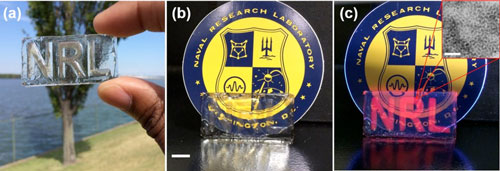|
NOVIDADES
U.S. Naval Research Laboratory scientists have developed and patented the fabrication of transparent, luminescent material they say could give smartphone and television screens flexible, stretchable, and shatterproof properties. The material is a thiol-yne nanocomposite polymer tailored to hold light-emitting quantum dots, tiny semiconductors whose size and composition can be precisely tuned to produce bright, clear, and energy-efficient colors. According to a study published by the lab's Optical Sciences Division (ACS Omega, "Fabrication of Photoluminescent Quantum Dot Thiol–yne Nanocomposites via Thermal Curing or Photopolymerization"), the thiol-yne polymer binds strongly to the quantum dots with a novel ligand and has a uniform distribution throughout the matrix. The material can be polymerized by ultraviolet light or thermal curing.  Frames a and b show the molded thiol–yne polymer block containing red quantum dots in ambient conditions (scale bar = 1 cm). Frame c shows the polymer block under ultraviolet light. Inset images shows the red quantum dots (1.5 µM) within the matrix (inset scale bar = 50 nanometers). Credit: U.S. Naval Research Laboratory
"Our invention creates a material with tailorable optical properties, which are dependent on the monomers used in the prepolymer formulation and/or depending on the Quantum Dots incorporated into the prepolymer," states the patent application, which included a photo of a tiny gecko that was created with the prepolymer resin and a 3D printer. TechLink's Austin Leach, a certified licensing professional, has been in contact with the lab and is excited to see the technology transition into the electronics marketplace. "Functionalized quantum dots produce color properties that make displays brighter and more realistic," Leach said. "Just think about the millions of mobile phones, flat-screen TVs, and touch screen devices in the world -- this could also make them stronger and more energy efficient." U.S. Naval Research Laboratory. Apr 12, 2019. |
|||||||||||||||||||||||||